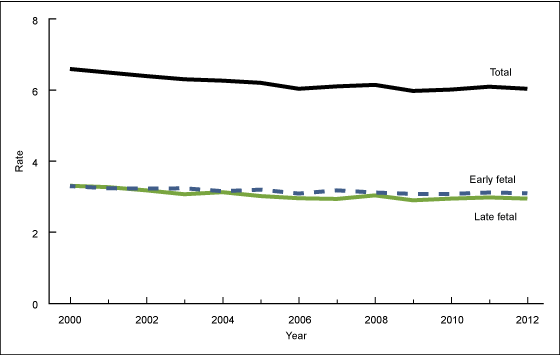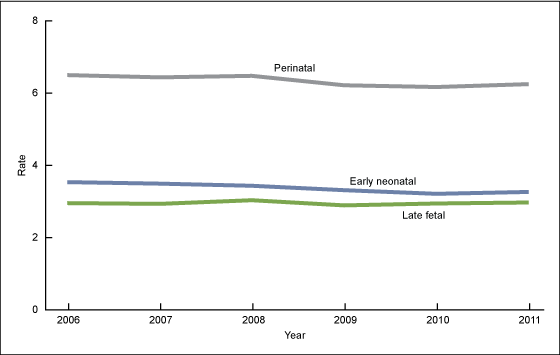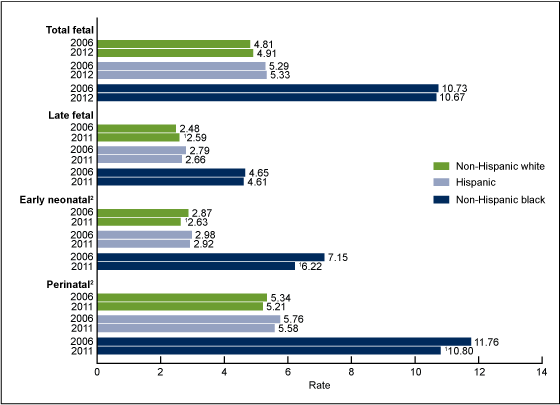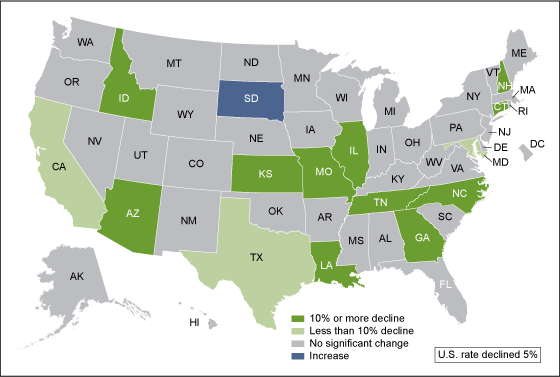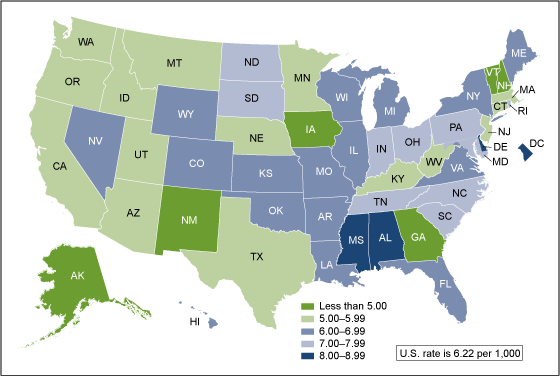Trends in Fetal and Perinatal Mortality in the United States, 2006–2012
- Key findings
- After declining from 2000–2006, overall, early, and late fetal mortality rates were essentially unchanged for 2006–2012.
- Early neonatal and perinatal mortality rates declined during 2006–2011.
- Fetal mortality rates were largely unchanged between 2006 and 2011, but some declines in early neonatal and perinatal mortality rates were seen.
- Perinatal mortality rates decreased in 14 states between 2005–2006 and 2010–2011.
- Large differences in perinatal mortality rates were seen across the United States in 2010–2011.
- Summary
- Definitions
- Data sources and methods
- About the authors
- References
- Suggested citation
NCHS Data Brief No. 169, November 2014
PDF Version (589 KB)
Elizabeth C.W. Gregory, M.P.H.; Marian F. MacDorman, Ph.D.; and Joyce A. Martin, M.P.H.
Key findings
Data from the National Vital Statistics System
- Following declines from 2000 through 2006, total, early, and late fetal mortality rates were generally flat from 2006 through 2012.
- Fetal mortality rates were essentially stable for non-Hispanic white (4.91 per 1,000 in 2012), non-Hispanic black (10.67), and Hispanic women (5.33) during 2006–2012.
- The overall perinatal mortality rate declined 4% from 6.51 per 1,000 in 2006 to 6.26 in 2011, with an 8% decline for non-Hispanic black women (10.80 in 2011).
- The perinatal mortality rate declined in 14 states, rose in 1 state, and was unchanged in 35 states and the District of Columbia between 2005–2006 and 2010–2011.
Changes in outcomes among live births were seen during 2006–2012. For example, the percentage of births delivered at 39 weeks of gestation or more rose 1) and preterm birth and infant mortality rates declined (1–3). Limited recent data, however, have been available on fetal mortality. This information is essential for a more complete understanding of pregnancy health in the United States. This report focuses on fetal deaths (spontaneous intrauterine deaths) at 20 weeks of gestation or more, sometimes referred to as stillbirths, using recently released national data. Trends are examined for fetal mortality for 2000–2012, focusing on the period 2006–2012, and for perinatal mortality by race and Hispanic origin for 2006–2011 (the latest year available) and by state for combined years 2005–2006 and 2010–2011.
Keywords: stillbirth, race and ethnicity
After declining from 2000–2006, overall, early, and late fetal mortality rates were essentially unchanged for 2006–2012.
Figure 1. Total, early, and late fetal mortality rates: United States, 2000–2012
NOTES: Total fetal mortality rate is the number of fetal deaths at 20 weeks of gestation or more per 1,000 live births and fetal deaths. Early fetal mortality rate is the number of fetal deaths at 20–27 weeks per 1,000 live births and fetal deaths at 20–27 weeks. Late fetal mortality rate is the number of fetal deaths at 28 weeks of gestation or more per 1,000 live births and fetal deaths at 28 weeks of gestation or more.
SOURCE: CDC/NCHS, National Vital Statistics System.
The U.S. fetal mortality rate declined 8% from 2000 through 2006 (6.61 to 6.05 per 1,000 births and fetal deaths). Declines over this period were seen in both the early fetal mortality rate (see Definitions ), down 6% from 3.31 per 1,000 to 3.10, and in the late fetal mortality rate (see Definitions ), down 11% from 3.32 to 2.97 (Figure 1).
From 2006 through 2012, the overall U.S. fetal mortality rate was generally stable, fluctuating only slightly over the period; the 2012 rate of 6.05 was the same as that for 2006.
The 2012 early fetal mortality rate (3.11) was essentially unchanged from 2006 (3.10), as was the late fetal mortality rate (2.96 in 2012 and 2.97 in 2006).
Early neonatal and perinatal mortality rates declined during 2006–2011.
In comparison with the stabilization in the late fetal mortality rate noted above, the early neonatal mortality rate (see Definitions ) declined from 3.55 per 1,000 in 2006 to 3.28 in 2011, a drop of 8% (Figure 2).
The perinatal mortality rate (see Definitions ) also followed a downward trend, though to a lesser degree, declining by less than 1% annually (from 6.51 in 2006 to 6.26 in 2011) for a total decline of 4%.
Figure 2. Late fetal, early neonatal, and perinatal mortality rates: United States, 2006–2011
NOTES: Late fetal mortality rate is the number of fetal deaths at 28 weeks of gestation or more per 1,000 live births and fetal deaths at 28 weeks of gestation or more. Early neonatal mortality rate is the number of infant deaths under age 7 days per 1,000 live births. Perinatal mortality rate is the number of infant deaths under age 7 days and fetal deaths at 28 weeks or more per 1,000 live births and fetal deaths at 28 weeks of gestation or more.
SOURCE: CDC/NCHS, National Vital Statistics System.
Fetal mortality rates were largely unchanged between 2006 and 2011, but some declines in early neonatal and perinatal mortality rates were seen.
From 2006 through 2012, total fetal mortality rates were essentially unchanged among the three largest race and Hispanic origin groups: non-Hispanic white, non-Hispanic black, and Hispanic women (Figure 3).
The early neonatal mortality rate declined among both non-Hispanic white (2.87 to 2.63 per 1,000) and non-Hispanic black (7.15 to 6.22) women from 2006 through 2011; the difference in rates for Hispanic women was not statistically significant (2.98 to 2.92).
The perinatal mortality rate was down 8% among non-Hispanic black women from 2006 through 2011, primarily as a result of the decline in early neonatal mortality; the risk of perinatal mortality did not change significantly for non-Hispanic white and Hispanic women over this time period.
Figure 3. Total fetal, late fetal, early neonatal, and perinatal mortality rates, by race and Hispanic origin of mother: United States, 2006, 2011, and 2012
1Change is significant at 0.05.
22011 is the most recent year for which neonatal death data are available.
NOTES: Total fetal mortality rate is the number of fetal deaths at 20 weeks of gestation or more per 1,000 live births and fetal deaths. Late fetal mortality rate is the number of fetal deaths at 28 weeks of gestation or more per 1,000 live births and fetal deaths at 28 weeks of gestation or more. Early neonatal mortality rate is the number of infant deaths under age 7 days per 1,000 live births. Perinatal mortality rate is the number of infant deaths under age 7 days and fetal deaths at 28 weeks of gestation or more per 1,000 live births and fetal deaths at 28 weeks of gestation or more.
SOURCE: CDC/NCHS, National Vital Statistics System.
Perinatal mortality rates decreased in 14 states between 2005–2006 and 2010–2011.
Perinatal mortality rates declined by 10% or more between 2005–2006 and 2010–2011 in Arizona, Connecticut, Georgia, Idaho, Illinois, Kansas, Louisiana, Missouri, New Hampshire, North Carolina, and Tennessee. Declines of less than 10% were seen in California, Maryland, and Texas (Figure 4).
The perinatal mortality rate rose in South Dakota between 2005–2006 and 2010–2011; changes for all other states and the District of Columbia were not statistically significant.
Figure 4. Percent change in perinatal mortality rate, by state: United States, 2005–2006 and 2010–2011
NOTE: Perinatal mortality rate is the number of infant deaths under age 7 days and fetal deaths at 28 weeks of gestation or more per 1,000 live births and fetal deaths at 28 weeks of gestation or more.
SOURCE: CDC/NCHS, National Vital Statistics System.
Large differences in perinatal mortality rates were seen across the United States in 2010–2011.
In 2010–2011, perinatal mortality rates in the United States ranged from a low of 3.65 per 1,000 in Vermont to a high of 8.91 in Mississippi (Figure 5).
Several states had rates under 5.0 (Alaska, Iowa, New Hampshire, New Mexico, and Vermont) for 2010–2011; three states (Alabama, Delaware, and Mississippi) and the District of Columbia had rates higher than 8.0.
Figure 5. Perinatal mortality rate, by state: United States, 2010–2011
NOTE: Perinatal mortality rate is the number of infant deaths under age 7 days and fetal deaths at 28 weeks of gestation or more per 1,000 live births and fetal deaths at 28 weeks of gestation or more.
SOURCE: CDC/NCHS, National Vital Statistics System.
Summary
Total, early, and late fetal mortality rates were generally flat in the United States from 2006 through 2012. Over this same period, fetal mortality rates were also essentially unchanged among each of the three largest race and Hispanic origin groups: non-Hispanic white, non-Hispanic black, and Hispanic women. The perinatal mortality rate declined 4% from 2006 through 2011, a result of a decrease in early neonatal mortality. The perinatal mortality rate fell 8% for non-Hispanic black women; declines among non-Hispanic white and Hispanic women were not statistically significant.
The continued decline in the perinatal mortality rate is noteworthy. The rate is down 10% since 2000 (4), and the pace of decline for the most current period, 2006–2011, is consistent with that for 2000–2005. The U.S. fetal mortality rate, however, did not improve during 2006–2012.
Definitions
Fetal death: Death prior to delivery of a product of human conception, irrespective of the duration of pregnancy, and which is not an induced termination of pregnancy (5).
Stillbirth: A fetal death that occurs later in pregnancy (at 20 weeks of gestation or more, or 28 weeks or more, for example).
Fetal mortality rate: Number of fetal deaths per 1,000 live births and fetal deaths. Rates based on data from the National Vital Statistics System (NVSS) are generally presented for fetal deaths of 20 weeks of gestation or more.
Early fetal death: A fetal death that occurs at 20–27 weeks of gestation.
Early fetal mortality rate: Number of fetal deaths at 20–27 weeks of gestation per 1,000 live births and fetal deaths at 20–27 weeks of gestation.
Late fetal death: A fetal death that occurs at 28 weeks of gestation or more.
Late fetal mortality rate: Number of fetal deaths at 28 weeks of gestation or more per 1,000 live births and fetal deaths at 28 weeks of gestation or more.
Early neonatal death: Death of a live-born infant under age 7 days.
Early neonatal mortality rate: Number of infant deaths under age 7 days per 1,000 live births.
Perinatal death: Infant deaths under age 7 days and fetal deaths at 28 weeks of gestation or more, often referred to as perinatal definition I.
Perinatal mortality rate: Number of infant deaths under age 7 days and fetal deaths at 28 weeks of gestation or more per 1,000 live births and fetal deaths at 28 weeks of gestation or more, often referred to as perinatal definition I.
Data sources and methods
This report contains data from the 2000–2012 Fetal Death Data Files, the 2006–2011 Linked Birth/Infant Death Data Sets, and the 2000–2012 Birth Data Files, NVSS. The Fetal Death Data Files contain information from all Reports of Fetal Death filed in the 50 states, the District of Columbia, and selected U.S. territories. Although reporting requirements for fetal deaths vary somewhat by state, fetal mortality rates from NVSS generally represent fetal deaths at 20 weeks of gestation or more (2,5). Fetal death data from NVSS are available by a wide range of maternal and infant characteristics (5). The Linked Birth/Infant Death Data Sets provide information on infant deaths and live births in the United States (3). The Birth Data Files provide information on the live births by gestational age and race and Hispanic origin (1). The number of births used to calculate rates in this report is from the birth file of the respective year. Fetal Death, Linked Birth/Infant Death, and Birth data sets are available from Vital Statistics Online.
About the authors
Elizabeth C.W. Gregory, Marian F. MacDorman, and Joyce A. Martin are with CDC’s National Center for Health Statistics, Division of Vital Statistics.
References
- Martin JA, Hamilton BE, Osterman MJK, et al. Births: Final data for 2012. National vital statistics reports; vol 62 no 9. Hyattsville, MD: National Center for Health Statistics. 2013.
- National Center for Health Statistics. Mortality multiple cause micro-data files.
- Mathews TJ, MacDorman MF. Infant mortality statistics from the 2010 period linked birth/infant death data set. National vital statistics reports; vol 62 no 8. Hyattsville, MD: National Center for Health Statistics. 2013.
- MacDorman MF, Kirmeyer SE, Wilson EC. Fetal and perinatal mortality, United States, 2006. National vital statistics reports; vol 60 no 8. Hyattsville, MD: National Center for Health Statistics. 2012.
- National Center for Health Statistics. Fetal death public-use data files (published annually).
Suggested citation
Gregory ECW, MacDorman MF, Martin JA. Trends in fetal and perinatal mortality in the United States, 2006–2012. NCHS data brief, no 169. Hyattsville, MD: National Center for Health Statistics. 2014.
Copyright information
All material appearing in this report is in the public domain and may be reproduced or copied without permission; citation as to source, however, is appreciated.
National Center for Health Statistics
Charles J. Rothwell, M.S., M.B.A., Director
Jennifer H. Madans, Ph.D., Associate Director for Science
Division of Vital Statistics
Delton Atkinson, M.P.H., M.P.H., P.M.P., Director
